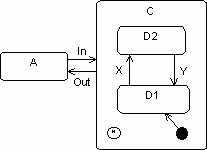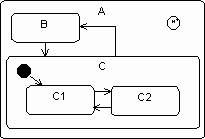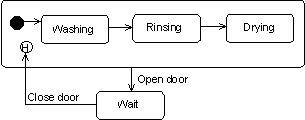
By default, a state machine does not have any memory. The special notation
offers a mechanism to memorize the substate last visited, and to get back to it during a transition entering the encompassing superstate. The history indicator applies to the level in which the H
symbol is declared. The H
symbol may be placed anywhere within the state — the bottom left corner is the default location.H
The following diagram represents a state
that memorizes the last active substate. The history is initialized when the transition issued from the initial state C
is triggered.A

It is also possible to memorizing the last active substate, regardless of its depth; this is indicated by the
symbol. The intermediate memory levels are obtained by placing a symbol H*
in each hierarchical level. In the following example, state H
memorizes the last active substate, independent of the nesting of substates.A

The next example shows the use of history to implement a dishwasher. The washing cycle is split into three main stages: washing, rinsing, and drying. The door may be opened at any time — to add a cup, for example. As soon as the door is closed, the washing cycle restarts at the same point as where it was stopped.
